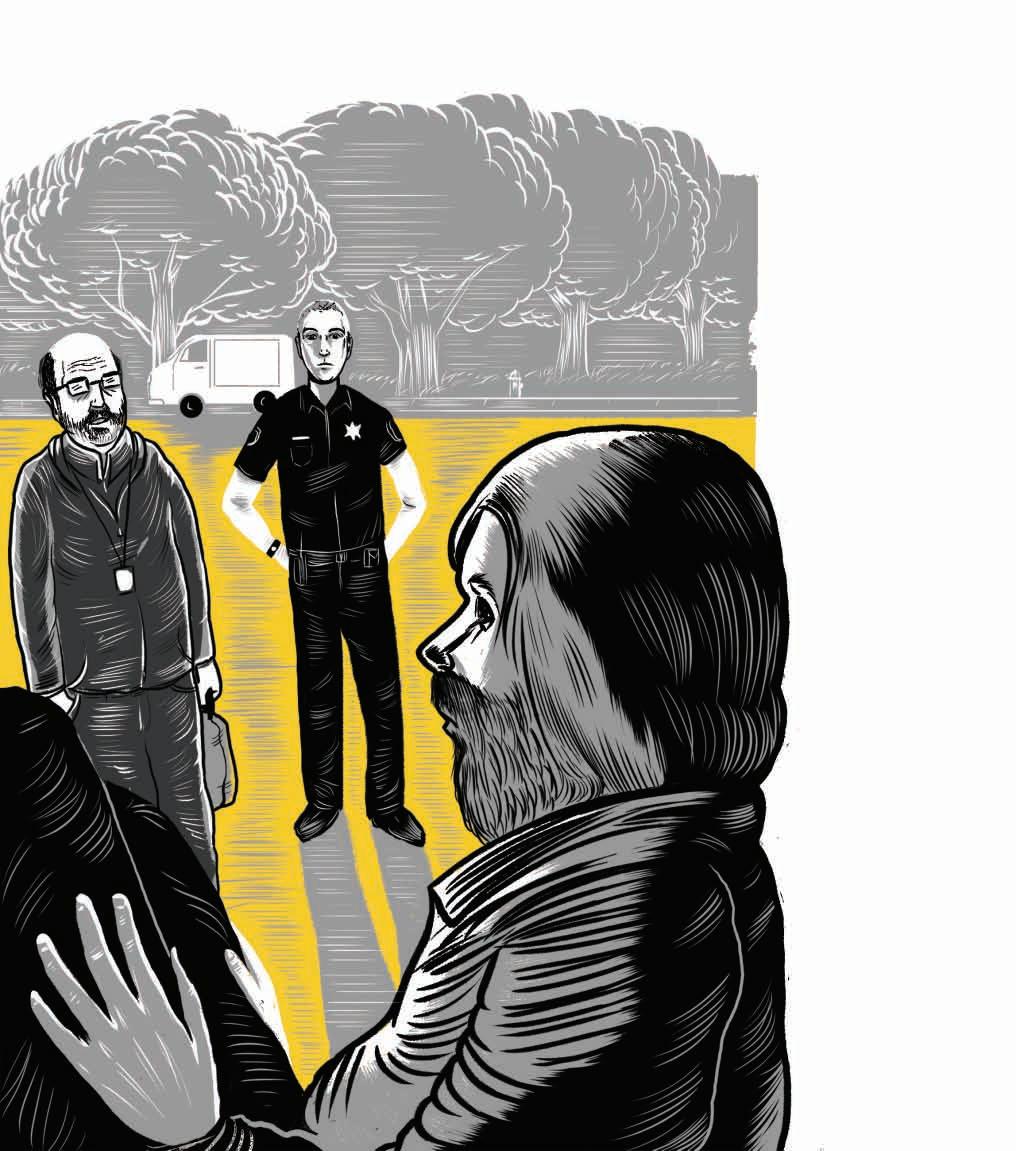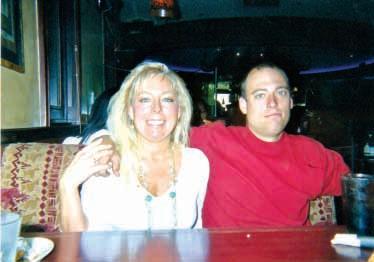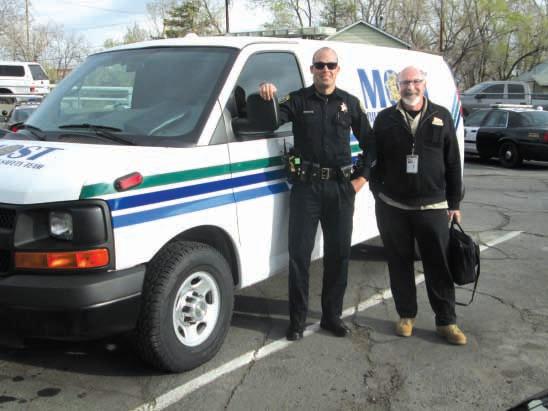
16 minute read
Feature
from July 10, 2014
COPS
Reno police reach out to troubled people
Advertisement
When I talk about the Fatal Encounters project, which focuses on people who’ve been killed by law enforcement in the United States since 2000, people often ask me if I’m scared of police. And except for times like this, standing outside the Reno Police Department’s main building—that white, vaguely Orwellian building on East Second Street—I’m not. Sure, I’ll never be able to be unaware where my hands are when I get pulled over again, but afraid? Don’t be ’noid.
But at 7:45 a.m. on a spring morning, a couple of weeks after a mostly satisfactory but woefully inadequate story about law enforcement-involved deaths was on the stands, I’d be lying if I said I didn’t worry that I’d forgotten to pay a ticket during that whole parking meter fiasco with the city of Reno.
And after months of doing research on the depressing topic of police killing Americans, it’s probably not all that surprising that the stuff gets into my head.
I was there at the invitation of Reno Police Officer Travis Warren to do a ride along with a MOST squad, so my presence couldn’t have been under friendlier circumstances. But still.
The MOST squad is those men and women who drive around in the white police vans with the green, blue and sky-blue racing stripes, the police badge in the
“O” and the words “Mobile Outreach
Safety Team” underlining the acronym.
This is the third installment in our year-long project looking at the issue of fatal encounters between law enforcement and people.
WRITTEN D. BRIAN BURGHART ILLUSTRATED JONATHAN BUCK DESIGN BRIAN BRENEMAN
The MOST team is a duo consisting of a mental health professional and a law enforcement officer.
Originally, in 2009-10, it was a partnership between Northern Nevada Adult Mental Health and the Reno Police Department. Since then, the program has grown in size, and gained partners and agencies, but its fundamental purpose remains the same—to stabilize threatening situations in which mostly mentally ill people “in crisis” are interacting with police.
After a few minutes, Warren opened the door, introduced himself, exchanged my driver’s license for a vistor’s ID, and led me into the labyrinthine building. I got a good vibe from him. He’s a photogenic guy, muscular, taller than average, with dimples and close-cropped hair, the kind of guy who probably hates to see himself described in print. He’d have worked fine as an actor on one of those 20th century TV shows that featured uniformed cops as the heroes—CHiPs, for example.
After the perfunctories, coffee and such, I was introduced to Warren’s partner, James Kilgore, and others on the squad. Kilgore is a stocky guy with glasses, and a goatee that goes from white in the mustache to gray in the beard. He’s got a broad, friendly demeanor and was dressed business casual. If I was going to place him in a pop culture context, I think he’d be a great fatherly character in a leather chair facing away from a patient in one of those mental health-oriented sitcoms like the Bob Newhart Show. The fact that he’s a mental health counselor probably adds to that.
Warren and Kilgore are eloquent representatives for MOST.
“We do emergency mental health calls, crisis stabilization and try to keep the person who’s struggling with the mental illness safe, try to keep the community safe, and last but not least, try to keep our officers safe,” Kilgore said. “If there’s a 911 call that comes in, we go out to that, and we intercept the situation. We try to determine at that point what would be the most successful recourse, where to refer them. We’re the mental health paramedics. … If they need to be taken to the hospital, we make sure that they get to the hospital. If we need to pass the baton and get them to Northern Nevada Adult Mental Health Services [his employer], we try to get them into our services and open the services, get counseling, get medications—whatever is needed to be able to get the person stabilized.
That’s a mouthful, and it’s only a few facets of one of the most progressive police programs I’ve heard of in Nevada (and cheap at around $250,000 a year). But let me throw some background at you. In my research regarding fatal encounters, the big untold story is the size of the percentage of mentally ill people in the United States who are killed by police. After researching in the neighborhood of a thousand instances, my feeling—since I still have collected just a drop in the bucket—is that the actual percentage is in the neighborhood of 30 percent. Another suspicion I have is that these types of deaths are most likely to happen, by percentage, in areas with lower urban density. Think Sparks vs. Las Vegas. In 2013 in Washoe County, three out of four people who were killed by police were mentally ill. In denser areas, police kill a higher than average percentage of minorities. In less dense areas, police kill a higher than average percentage of mentally ill people.
It makes sense, right? Who else is going to pull a knife or a gun or charge cops with a stick? Nobody in their right mind, to be indelicate. And yet, mental illness doesn’t make someone an inaccurate shot, and police are trained to respond to neutralize the threat to themselves or bystanders.
The MOST squad was created to prevent, as often as possible, that horrible sort of outcome. The teams go out in the community to get comfortable with people who suffer from various mental health issues before they’re “in crisis” so they can be of value at the moment of truth. Despite the fancy stripes, the van isn’t what you’d call luxurious. It’s got the cop car electronic set-up, but there’s no moon roof or Corinthian leather seats or anything. The most interesting thing about it is the seating options behind the partition in back. There’s a bench seat and a single bucket seat that appears to be designed for people who are balance impaired or who need to be restrained. I’ve spent my life avoiding a ride in that particular chair.
Warren and I come to a quick agreement about protocol. I’m fine with withholding people’s names, and believe it or not, I’m also fine with getting dumped off at 7-Eleven if there’s a 10-78, which is basically a situation too dangerous for us “civilians” without bullet-proof vests.
We’re barely on the road before we get our first call. A homeless couple is having a dispute next to a law office on Arlington Avenue, just south of the river, and we go to investigate, as do other patrol cars.
While the woman has disappeared, we find the guy. His camp is well-hidden, spitting distance from the avenue, but completely camouflaged. That in itself is a bit of an eye-opener for me. He’s tucked into a little spot out of the wind. Affable enough, officers move in to talk to him and establish that he’s not a threat to others or himself and then Kilgore moves in with his soothing presence. “Ed” acknowledges he could use a bit of detox, and after he throws most of his possessions in a Dumpster, we oblige him with a lift.
I don’t want to get into a recitation of the day’s activities. Suffice it to say even though Warren kept remarking that it was a quiet morning, we kept going
CONTINUED ON PAGE 15
iRReconcilaBle diffeRences
Bad things shouldn’t happen on Christmas day, but sometimes they do. People shouldn’t be alone on Christmas day, but sometimes they are. People shouldn’t work on Christmas day, and sometimes they don’t. But sometimes they do. The world is filled with such inconsistencies.
Micah Abbey, 33, had wanted nothing more than to play penny slots at John Ascuaga’s Nugget on the evening of December 25, 2011. He’d been to a Christmas party earlier, and he was happy. He had plans to go to the Nugget with his buddy James Faulkner, but it turned out Citifare stopped service at 5 p.m., Faulkner said, and Abbey would have been stuck in Sparks. Since he lived at 9801 Crystalline Drive out in Stead—a group home owned by Project Uplift for people with mental illness who are transitioning to living on their own—coming to town seemed impractical, so they had to cancel.
Abbey was undoubtedly disappointed, and it’s pretty obvious that Faulkner feels some guilt over it, especially in light of what happened.
It’s hard to gain perspective on the evening of Abbey’s death at the hands of police. Police reports are certainly a version of the truth, records down to the minute. But the story they tell of the person is diametrically opposed to what the people who knew him best had to say. It’s a question of perspective, isn’t it? Police—and the public, generally—want to see evidence of the bad guy whose actions put him in a position where he essentially killed himself, although he used other people as his agents. It’s human nature. Friends and family see the guy who took care of his grandma, who didn’t drink, smoke or do drugs, who worked hard despite his bad back, who helped his aging housemates, who wasn’t unstable, just a bit emotionally damaged by a divorce. It’s human nature.
Here’s how one investigator described the man: “Micah Steven Abbey had a history of mental illness to include major depression, anxiety disorder, post traumatic stress disorder, and rule out bipolar disorder. Micah injured his back in an accident and had a herniated disc operated on. Micah was left with 25 percent numbness starting in his lower back and going down his legs to his feet. Micah was taking several medications to include Depakote, Paxil, Geodon, Diazepam, Flexeril and Oxycodone. Micah had a history of drug abuse to include synthetic marijuana known as “Spice,” and conflicts involving violence, the police and suicidal statements.”
The investigator said that Abbey was upset because his brother was about to be released from prison. “The daytime caretaker Anita Ritt said that Micah was pacing, grunting like an animal, and had to go on several walks to calm himself down. Micah made comments about “going gangsta” on the people that put his brother in jail.”
Michael Ross gave him his medications at 7 o’clock, but it was less than an hour later that, police say, he was yelling at another resident about his missing backpack. “Michael told Micah that he couldn’t handle the situation by yelling and getting upset. Micah shoved Michael, slammed his body into Michael, and was yelling at Michael while holding a fork in his outstretched arm.” Ross called

911. There are three public documents associated with this incident, one from the Washoe County Sheriff’s Office at http://bit.ly/1lC2Pid; one from the University of Nevada, Reno, Police Department at http:// bit.ly/VhxVGu; the complaint in federal court alleging that Abbey was wrongfully killed, http://bit. ly/1zacnuR.
All the documents depict chaos in that small bedroom. That a 165-pound man with a bad back could take on up to four trained police officers from Reno and the University of Nevada, Reno is hard to reconcile. It’s hard to reconcile that to restrain him up to four men would have to beat him with batons, taser him 26 times, place him in a chokehold or hogtie him on his stomach with his wrists and ankles cuffed and tied together. It’s hard to reconcile that they didn’t need expend this much energy to subdue him, either, simply because, if they didn’t need to, why would they?
And yet, there’s little in any of these documents that disputes these facts.
Micah Abbey’s grandmother Anita Nelon cries when she talks to a stranger on the telephone about his death. She’s still got the accent from her native lands of Copenhagen and Denmark, but she’s been here for decades.
“It’s such a big loss, such a big loss,” she said. “He was such a soft soul. He was the sweetest, most thoughtful boy. ‘Grandma, what can I help you with today?’ It’s been like a nightmare. That should not have happened. Not to him. Not to him.”
Micah Abbey and his mother, Denise Abbey, pose in happier times.
42 MPG HWY.


from event to event. We went from people suffering from substance abuse to one man with a nearly complete psychotic break with reality—he was dying on his feet, but refused treatment—to an assisted-living facility, and then to a pregnant and dehydrated meth addict. And through it all was that uncommon authority-mixed-with-sympathy teamwork.
There was one man, though, who struck me as symbolic of the day. We were called to some apartments off Booth Street. Somebody had called 911 saying their relative, “Fidel,” was threatening to commit suicide by eating rat poison. My pulse quickened as we wove on foot through that apartment complex, not quite certain of the apartment number or the man’s location. When we found him, he invited us into the worn but comfortable enough living room. Kilgore and Fidel talked about work history, alcohol and drug use, relationship status, all the things you’d expect to talk about in a shrink’s office. Fidel sheepishly admitted that he had no intention of harming himself, he was just trying to get attention from his estranged girlfriend. However, I wasn’t convinced that was the truth of things when we sat down, even though I believe it was the truth when we left. It felt to me like he was in need of some sympathy because the people around him weren’t acknowledging his psychic pain.
I know that sounds a little touchy-feely, but that’s essentially all that transpired in the time between the uncomfortable search for the apartment, and us leaving, success defined by an appointment set for Warren and Kilgore to stop by and visit “just to check” in a couple of days. It wasn’t anything miraculous, but it’s probably nothing that would have happened if officers less trained in mental-health issues had responded to the call.
The vast majority of encounters that Warren and Kilgore are faced with are like that—human interactions that plant a friendly seed in case the person ever ends up in crisis.
Warren said the crisis situations are much less common. He has two that are emblematic of the big payoff
for the small investment of the MOST program. In one, another RPD affiliate of the team, Colleen Guilford, a “COPS” trained negotiator—Warren is a negotiator as well—was able to communicate with a person who’d already fired one shotgun round into a wall and then set off down the road with the firearm. He thought he was taking out the media that was always spying on him and stealing his ideas. But instead of becoming a statistic, he’s getting the help he needs. “And that was really, really big,” said Warren. “Colleen was convinced—all the officers there were convinced to a degree—that they were going to have to shoot this kid. And he did everything right. If he would have done one thing wrong, it would have changed. But he did everything right, and she did everything right. “There’s a lot of interventions that we have done that have actually spared our community a lot of pain and a lot of difficulties. There’s one in particular that we worked out when we first started working together. There was a subject who came into town that had nine firearms, over 4,000 rounds of ammunition, and his fantasy was to enact some kind of global change and to get everyone’s attention. He was either going to go to a mall or a school and shoot people. And we were able to intervene and get him into the hospital, followed up, he’s doing well now. He’s under psychiatric care, and he’s being monitored. “The community never really hears about those kinds of things.” The van comes to a stop in the back parking lot of that Orwellian building on East Second Street. I’m in a rush to make another meeting. The hallways no longer seem like a labyrinth designed to keep me off balance, and even though I make it outside before I remember the cops have my driver’s license, I’m not hesitant to go back in to retrieve it. Warren and Kilgore are able to make friendly connections with potentially unstable people in the community, helping them be more comfortable with police officers. Walking back into the police station, I realized that their engagement with me, a journalist who documents killings by law enforcement, had the same effect: I was now a little more comfortable. Ω
Officer Travis Warren and Jim Kilgore pose for a second before with the MOST van before heading out to interact with troubled community members. In an interview in March, Reno Police Chief Steve Pitts and Deputy Chief Mac Venzon talked about the many methods local law enforcement have at their disposal for improving protocol, training and policies.
Chief Pitts said our local law enforcement agencies look to other agencies—particularly in areas of community-oriented policing—for policies that work best to mitigate negative outcomes, like officer-involved deaths.
“The simple answer, the Reader’s Digest version of our policy is we write our policy,” Pitts said, and that includes constant re-examinations, updates and training on changes. “But we are definitely going to examine the best practices in the country. We have actually examined practices in the UK, when it comes to community policing, because they actually do a very good job of things there, that we could improve on. And so we’ll take best practices. We’ll take ideas, suggestions at many levels and make sure it fits into our philosophy of policing the community.”
Other methods for introducing new policies and ideas include Lexipol, www.lexipol.com, a national organization that regularly compares local policies to national, federal and state statues, case law, regulations and best practices, and it audits changes from a riskmanagement standpoint. RPD doesn’t use it, but the Washoe County Sheriff’s Office does. Pitts said the Force Science Institute, www.forcescience.org, is also an available resource. According to its website, Force Science is a think tank regarding “research and application of unbiased scientific principles and processes to determine the true nature of human behavior in high stress and deadly force encounters.”
With regard to mentally-ill people, Pitts said Reno police have three primary assets, crisis intervention training (CIT), which he estimated 70-80 percent of RPD officers have undergone, the MOST squad (see main story, page 12), and crisis intervention negotiations training (CINT), which is training in negotiating with people who are in crisis (not specifically mentally-ill people).
In addition, changes have been made at RPD based on the 2012 Department of Justice investigation into the Las Vegas Metropolitan Police Department, Deputy Chief Venzon said. That report resulted in 40 reform recommendations, from which RPD pulled three particular areas for reform of its policies. Those polices focused on the de-escalation approach, critical incident review and realitybased training.
“You take some of those recommendations, and incorporate them and a few other things,” Venzon said. “Those are the three things to me that really hit home.”
The full DOJ report is available at https://drive.google. com/file/d/0B-l9Ys3cd80fQ3d0 VVlkaVJvNGNSNTlTVjF6ekJvVD duVzRz/edit?usp=sharing.

—D. Brian Burghart











